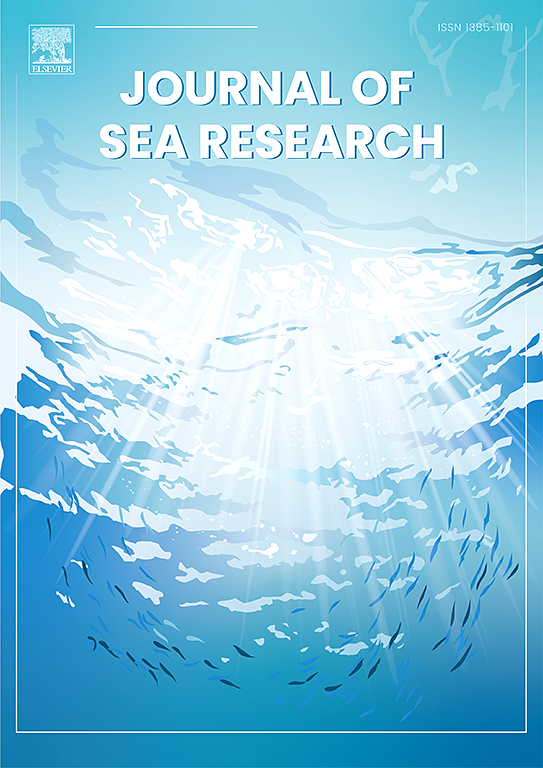Distribution mechanism of Ocypodoidea in intertidal zone of north shore of Hangzhou Bay (Crustacea: Decapoda: Brachyura)
IF 2.9
4区 地球科学
Q2 MARINE & FRESHWATER BIOLOGY
引用次数: 0
Abstract
The protection of estuarine intertidal zones is a global hotspot issue. Ocypodoidea crabs are key components of intertidal ecosystems. Understanding the driving mechanisms behind the distribution of Ocypodoidea crabs is of great significance for intertidal conservation. The study, which combined an intertidal zone survey with laboratory salinity selection experiments, investigated the distribution of Ocypodoidea and the environmental factors driving their distribution along the north shore of Hangzhou Bay. The results indicate that we collected a total of 6 Ocypodoidea species, among which Uca arcuata, Macrophthalmus abbreviatus, Macrophthalmus banzai, and Ilyoplax deschampsi were dominant. Under natural conditions, from the bay head to the bay mouth, the four Ocypodoidea crab species transition from freshwater-adapted species (I. deschampsi) to saltwater-adapted species (U. arcuata, M. abbreviatus, M. banzai) along the increasing salinity gradient. Laboratory experiments demonstrated that salinity had an indirect influence on the distribution of I. deschampsi possibly mediated by biological competition. These crabs prefer distinct substrate types (divided into vegetated salt marsh, bare muddy flats and bare sandy flats). Macrophthalmus banzai and M. abbreviatus inhabit bare muddy and sandy flats. Ilyoplax deschampsi adapts to both. Uca arcuata inhabits vegetated salt marsh together with those two flats. Differences in crab substrate preferences and the presence or absence of these substrate types across different sections further drive compositional differences in the Ocypodoidea community. Human activities have altered the distribution patterns of salinity and the aforementioned substrate types along the north shore of Hangzhou Bay, likely driving shifts in the spatial distribution of Ocypodoidea crabs.

杭州湾北岸潮间带桡足总科分布机制(甲壳纲:十足纲:腕足目)
河口潮间带的保护是一个全球性的热点问题。蟹科是潮间带生态系统的重要组成部分。了解蟹类分布背后的驱动机制对潮间带保护具有重要意义。采用潮间带调查与室内盐度选择实验相结合的方法,研究了杭州湾北岸鲤科(ocypodo总科)的分布及其环境因素。结果表明,共采集到棘足总科6种,其中以圆角大鼠、短巨眼鼠、斑巨眼鼠和德尚巨眼鼠为优势种。在自然条件下,从湾头到湾口,四种蟹类从淡水适应种(I. deschampsi)到咸水适应种(U. arcuata, M.缩写,M. banzai)沿盐度梯度逐渐增大。室内实验表明,盐度可能通过生物竞争间接影响了德尚水蚤的分布。这些螃蟹喜欢不同的基质类型(分为植被盐沼、裸露的泥地和裸露的沙地)。大眼鼠和短眼鼠栖息在裸露的泥泞和沙质平原上。德尚伊洛普斯适应了这两种情况。乌卡和那两个滩涂一起生活在盐沼里。蟹对基质的偏好差异以及这些基质类型在不同剖面上的存在或不存在,进一步推动了蟹纲群落的组成差异。人类活动改变了杭州湾北岸盐度和上述基质类型的分布格局,可能驱动了蟹类空间分布的变化。
本文章由计算机程序翻译,如有差异,请以英文原文为准。
求助全文
约1分钟内获得全文
求助全文
来源期刊

Journal of Sea Research
地学-海洋学
CiteScore
3.20
自引率
5.00%
发文量
86
审稿时长
6-12 weeks
期刊介绍:
The Journal of Sea Research is an international and multidisciplinary periodical on marine research, with an emphasis on the functioning of marine ecosystems in coastal and shelf seas, including intertidal, estuarine and brackish environments. As several subdisciplines add to this aim, manuscripts are welcome from the fields of marine biology, marine chemistry, marine sedimentology and physical oceanography, provided they add to the understanding of ecosystem processes.
 求助内容:
求助内容: 应助结果提醒方式:
应助结果提醒方式:


